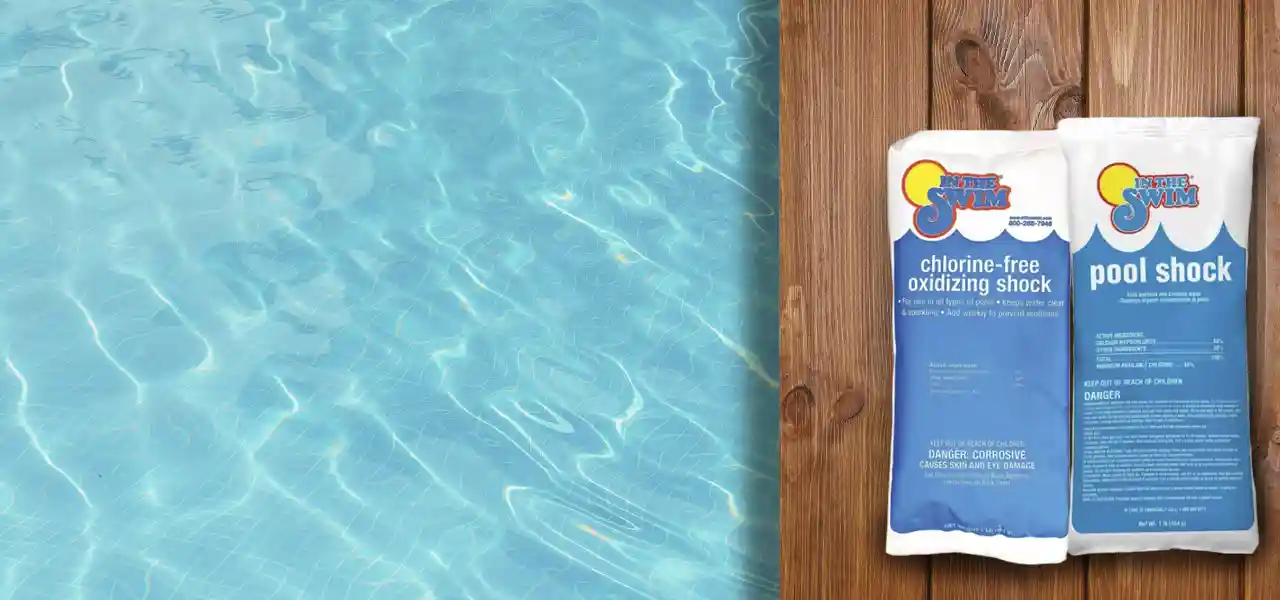FREE Standard Shipping On All Orders $100 or More!*

Chlorine Shock Vs. Non-Chlorine Shock
In the realm of pool maintenance, the debate between using chlorine shock or non-chlorine shock has been a hot topic for quite some time now. While both have the same job, there are notable differences between the two. As you wade through the options, weighing the pros and cons, the big question is, “which shock treatment takes the crown for giving you the perfect pool water?”
Let’s dive into the nitty-gritty of chlorine versus non-chlorine shock and answer this ever-so-popular question.
Non-Chlorine Shock
Chlorine-free shock treatments usually have Oxy in the name, because they contain oxygen, with salts of potassium. Some call this type of shock MPS, short for monopersulfate, which is short for the longer name potassium peroxymonopersulfate. Chlorine-free shock has its advantages, and also disadvantages, when compared to the 3 types of chlorine-based pool shock that is normally available.
Pros:

- Quick release, fast acting, no residue, no odor
- pH balanced, no effect on pH
- Oxidizes organic contaminants to purify water
- Removes chloramines and ammonia
- No pre-dissolving needed, pour into pool
- Can swim immediately, no waiting period
- Won't bleach or fade vinyl liners or swimsuits
- Won't add calcium or cyanuric acid to the pool
Cons:
- Costs about 10% more than chlorine shock
- Not very effective for algae treatment
- Not very effective for bacteria treatment
Best Uses:
- Chloramine removal: Chlorine-free shock can be used effectively to break apart combined chlorine molecules, and restore a foul-smelling, red-eye pool back to normal, without super-dosing on chlorine. Interestingly, however, non-chlorine shock will interfere with the Total Chlorine DPD #3 reagent, making it appear like there are chloramines, when there are not. A De-Ox reagent can be added to remove the interference of MPS on pools using non-chlorine shock.
- Contaminant removal: Non-chlorine shock does a great job of attacking the daily onslaught of natural and organic contaminants that end up in your pool. Dust, dirt, leaves, bird droppings, insects, grass clippings - and body oils and swimmer waste too. Helps your chlorine and your pool filter by removing most of the solids and particles (seen and unseen) from the water, to make sanitation and filtration more efficient.
Chlorine Shock
Chlorine shock treatments come in three types: Cal Hypo, Lithium Hypo, and Dichlor. Calcium Hypochlorite (Cal Hypo) is the most common type of chlorine pool shock and the cheapest, available in two strengths, regular and super. Lithium hypochlorite contains no calcium and dissolves instantly, but is less powerful (and more costly) than Cal Hypo. Dichlor is a stabilized granular pool shock, made with cyanuric acid to protect it from the sun and keep it active longer.
Pros:

- Quick release, fast acting
- Oxidizes organic contaminants to purify water
- Removes chloramines and ammonia
- Kills algae and bacteria easily to disinfect water
- Cheapest way to shock the pool (Cal Hypo)
Cons:
- Pre-dissolving granular is recommended for surface protection
- Waiting period of 12-24 hours is generally recommended
- High levels of chlorine can be harsh on soft and shiny surfaces
- Cal Hypo adds calcium, and Dichlor adds cyanuric acid (a 'Pro' in some cases)
- Higher pH levels, except for Dichlor (a 'Pro' in some cases)
- Generally more hazardous to store and use, and with strong odor
- Residue of 'shock dust' is often left, or water becomes cloudy
Best Uses:
In addition to performing the contaminant and chloramine removal job that chlorine-free shock can do (discussed above), chlorine shock goes beyond, for control and removal of all types of algae and bacteria.
- Algae removal: Chlorine shock stands tall in the face of severe algae blooms. Non-chlorine shock will have some effect on small localized blooms, but for a green pool, add enough chlorine pool shock to reach 30 ppm (with a suitably low pH level and balanced alkalinity and calcium levels), and the algae will suddenly succumb. Granular pool shock is the best treatment for pool algae.
- Bacteria removal: Granular chlorine penetrates deep into cellular membranes, to the nucleus of the cell, completely destroying it from the inside out. Non-chlorine shock will destroy your basic bacteria, but for the stronger varieties, it just can't get past their defensive walls. For control of pathogenic bacteria, those that can make you sick, a shock treatment with chlorine will neutralize 100% of germs to sanitize and disinfect the water.
So, Which is Better?
It used to be that there was a big difference in price, with non-chlorine shock being much more costly, but now they are nearly equal in price.
Non-chlorine shock has a lot of advantages, and could be used as the primary oxidizer for a pool or spa, saving use of chlorine shock for instances like pool opening, algae blooms, or high bather load (lots of swimmers or hot tubbers). For general contaminant and chloramine removal, which helps your overall sanitation and filtration, why not give non-chlorine shock a try - it's gentler with far fewer side effects.
Overall, we recommend using both types! Use a non-chlorine shock for general oxidation, and use a chlorine shock for those less frequent occasions listed above, where the power of chlorine is really needed.